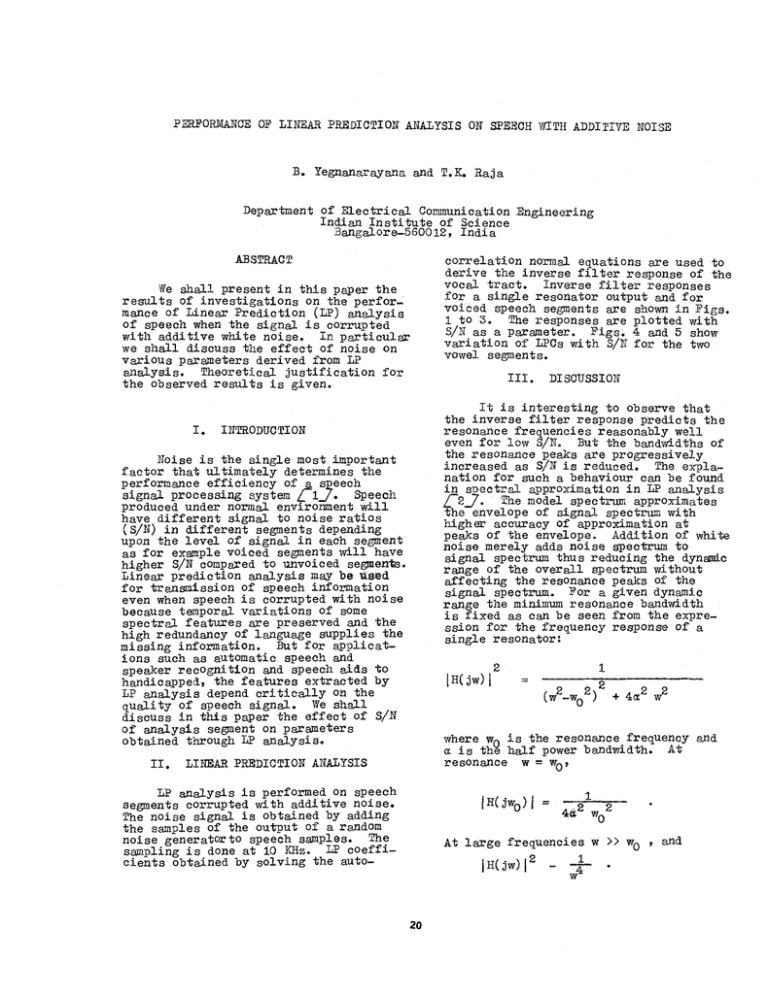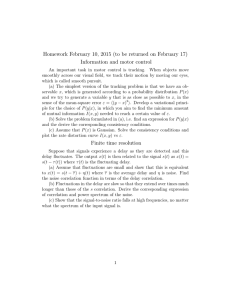Document 13759565
advertisement

PEORM1qCE OF LINEAR PREDICTION ANALYSIS ON SPEECH PITH ADDITIVE NOISE B. Yegnanarayana and T,K. Raja Department of Electrical Communication Indian Institute of Science Engineering Bangalore—5600 12, India correlation normal equations are used to derive the inverse filter response of the vocal tract. Inverse filter responses for a single resonator output and for voiced speech segments are shown in Figs. 1 to 3. The responses are plotted with S/N as a parameter. Pigs. 4 and 5 show variation of LPC3 with S/N for the two ABSTRACT We shall present in this paper the results of investigationson the perfor— mance of Linear Prediction (LP) analysis of speech when the signal is corrupted with additive white noise. In particular we shall discuss the effect of noise on various parameters derived from LP analysis. Theoretical justification for the observed results is given. I. vowel segments. U It is interesting to observe that the inverse filter response predicts the resonance frequencies reasonably well even for low S/N. But the bandwidths of the resonance peaks are progressively increased as S/N is reduced. The explanation for such a behaviour can be found in sectra3 approximation in LP analysis C2J. The model spectrum approximates the envelope of signal spectrum with higher accuracy of approximation at peaks of the envelope. Addition of white noise merely adds noise spectrum to signal spectrum thus reducing the dynamic range of the overall spectrum without affecting the resonance peaks of the signal spectrum. For a given dynamic range the minimum resonance bandwidth is fixed as can be seen from the expression for the frequency response of a single resonator: INTRODUCTION Noise is the single most important factor that ultimately determines the performance efficiency of speech signal processing system L 1J. Speech produced under normal environment will have different signal to noise ratios (s/N) in different segments depending upon the level of signal in each segment as for example voiced segments will have higher S/N compared to unvoiced segments. Linear prediction analysis may be twed for transmission of speech information even when speech is corruptedwith noise because temporal variations of some spectral features are preserved and the high redundancy of language supplies the missing information, But for applications such as automatic speech and speakerrecOgnitiOn and speech aids to handicapped, the features extracted by LP analysis depend critically on the quality of speech signal. We shall discuss in this paper the effect of S/N of analysis segment on parameters obtained through IP analysis. II. 10 2 1 [H(jw) (w2—w02) — + 42 w2 where w is the resonance frequency and is th half power bandwidth. At resonance LI1EAR PREDICTION ANALYSIS LP analysis is performed on speech segments corrupted with additive noise. The noise signal i5 obtained by adding w tH(Jwo) the samples of the output of a random noise generator to speech samples. The sampling is done at 10 KHz. LP coefficients obtained by solving the auto— = 1 A2 - 2 wo At large frequencies w >> w0 IH(iw)12 20 - —1— , and S/N 4d 42. 2.4 )2. 6 Pig.1: Inverse filter responses —-V for a (Resonance fre1500 Hz and bandwidth=150 Hz) single resonator model quency 0 S/N 0 Hz OOO 1z 2500 filter response for Fig. 3: Inverse the vowel segment iI * i1.lthough formant frequencies are Fig. 2: Inverse filter responses for the Let estimated cortiectly even under poor S/N conditions it is difficult identify them from IP magnitude spectrum by peak picking methods especiallywhen the each other or when peaks are close a1. the of inter- frequency est.w1Then thehighest dynamic range d is given be to [3J w02 4*z2w2 The )/kw47 is estimated correctly by LP bandwidth can be isinautomatically increased as 1. seen above discussion indicates that vocôders abould perform satisfactorily even for noisy speech as the temporal variations of formant frequencies are preserved. However when LPC or related parameters such as reflection coeffici— LP w and w is fbced, the dynajizic analyai range is inverely proportional to square of bandwidth. Therefore if d is reduced Since $ the bandwidths are large. Derivative of LP phase spectrum can be effectively used for this purpose as shown in Pig. 6 for a two resonator model. by (2 i formants are 1 lower to about 10 dB, 5oooHZ vowel segment For speeo]a.gnal not generally affectedhigher as much as the first formant when S/N reduced. This because the first forsiant has much lower bandwidth and it requires large dynamic range for accurate estimation. fact better estimates of higher for— mants are obtained by reducing the dynamic range which is usually realized by providing high frequency emphasis at stage. In Fig.2 higher preprocessing formants are clearly resolved when s/N enta and area functions are used in speech recognition or speaker verification systems, additive noise increases the Fig. 21 0 20 (sh) dS Pig. 5: LPCs for the vowel 30 senent 5G?JAL tat. (5h) dB Fig 4: ]Os for the vowel seientIit intra—vari ation significantly making difficult to design pattern recognition0 classifiers for it Typical variations ol' LPO5 with noise for two voiced segments are shown in Pigs. 4 and 5. The changes in LPC5 even at 30 4B S/N i5 the coeffisignificant and the ordering cients disturbed as noise level increases, One of the important applications of LP analysis is to obtain nonuniform acoustic tube model for vocal area functions0 When tract in terms ofused such models are an aids to handi- 1 capped the noise level becomes a factor, (a.) 4z critical Pig.6 5c0 Hz (tb) 2 ,&4Z Pormant extraction using LP phase spectrum (a) Frequency response (b) 22 IZ Differentiated phase spectrum IV. CONCLUSIONS Although speech is intelligible even at low S/N parameters extracted from speech vary significantly with S/N. We have shown that for vowel segments s/N below 20 4B reduces dynamic range of spectrum and increases error in estimating parameters. Por low level speech , segments such as unvoiced sounds the will be very low making parametric S/N extraction by LP analysis extremely difficult. ACKNOWLEDGMENTS The authors wish to thank Prof. B.S, V.113. Sarma and Mr. Rama1ishna, Dr. T,V. Ananthapadmanabha for many useful discussions. Pig.?: Normalized error for the vowel REIPERENCES segment 1. D.R. Reddy, 'Speech Recognition by Machine:A Review', Proc. IEEE Vol.64, No.6, p.501, April 1976. 2 J, Makhoul, Tutorial No. 3. 4, p. 'Linear Prediction: A Review', Proc. IEEE, 1101,63, 561, April 1975. B. Yegnanarayana, 'Pornant Extraction from Linear Prediction Phase Spectra', (submitted). 20 (SJ)da Pig. 8: Normalized segment lii error for the vowel is the nor— Another useful parameter error whieh is plotted for different s/N Pigs. 7 and 8 for two vowel segments. Although the general behaviour depicted is to be eected, it is interesting to note that the error increases The steeply below about 20 dB s/N. also show that normalized error figures increases as the dynamic range of the malizecl. in spectrum decreases. 23




